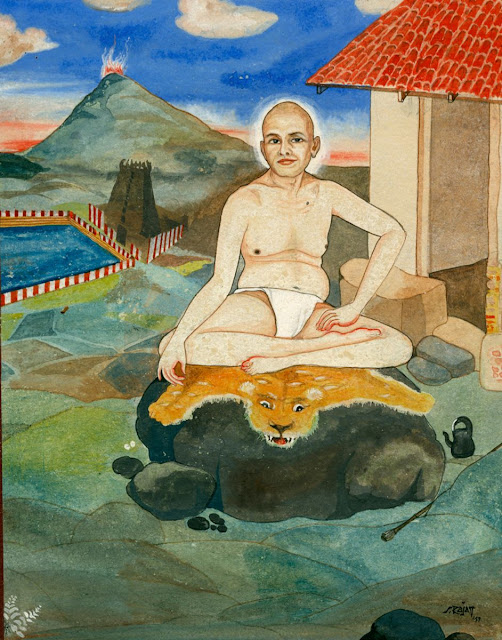In my earlier posting of the 2013 Mahashivaratri Kolams inside the Arunachaleswarar Temple, one of the Kolams depicted Sri Idaikadar (Edaikadar), one of the 18 renowned Siddhas of Tamil Nadu who was considered to be an incarnation of Lord Vishnu.
One of his biggest contributions is regarded as the invention of Kayakalpa (body rejuvenation) techniques. Kayakalpa is believed to purify, nurture and revitalise the constituent elements of the body, mind and psyche with a series of customized therapy sessions, herbo-mineral preparations, vital breathing practices, dietary guidelines, and daily living recommendations.
His other contribution to Hindu practices is the current arrangement of Navagrahas (Nine Planets) in Temples. Originally, all the planets were positioned to face the Sun. However, Idaikadar saw that the original arrangement would feed the cycle of karmas of an individual. With each planet facing one another an individual would have a more difficult time breaking the grip of karmas that the planets deliver. Idaikadar used his yogic powers to ascertain a new positioning of the planets which would ensure that no two planets would face each other. In this way, a person who remedies a bad Saturn or bad Mars, would be able to deal directly with the powerful planet. It is Idaikadar who is responsible for the modern day arrangement of the Nine Planets used in all the Temples throughout India.
It is believed that Idaikadar was born sometime around the 3rd Century B.C. with a lifespan of around 600 years. The story of his attainment of yogic powers and rearrangement of the planets goes like this:
“Idaikadar lived as a humble cowherder and his daily routine was to take his cows to grassland in the morning and then in the evening bring them back to their sheds. One morning a respected Saint came to his hut and Idaikadar welcomed him. The saint observing the good hearted nature of the cowherder stayed for some days and taught him saying, 'Dear son, hearing and learning are easy. Showing one’s learning and power is commonplace in the world. You should not become as a goat in a herd. Instead live uniquely and lead the word in a proper way.'
As Idaikadar’s spiritual practices became more intense, his physic vision showed him an upcoming dark period of a terrible drought. After this vision and heartfelt prayers, he came up with the idea to train his cows to eat ‘Erukku’ (a milky plant common in harsh, waterless areas). He also mixed grains with wet soil and coated them on the walls of his hut.
As he predicted, a dreadful drought came exhausting all water supplies and leading to the ruination of crops. Many of the feeble and ill died, however Idaikadar’s cows grew stronger each day by heartily eating the ‘Erukku’ plant. As the plant gave the cows an uncontrollable itch, the cows scratched their bodies against the walls of Idaikadar’s hut, which were coated with the mixture of grains and soil. This made the grains fall from the hut onto the ground, whereupon Idaikadar ate them with cow’s milk as his food.
As the drought continued, most living beings were eliminated from the earth. But, Idaikadar and his cows continued to grow in strength and health. On viewing this the Nine Planets (Navagrahas) visited the cowherder to learn of his secret. He saluted the Planets, gave them mats and milk with grains. After their meal, the Planets slept and as soon as Idaikadar noticed that they were asleep, he rearranged them in an order that would be beneficial to mankind making sure that none of the Planets faced one another. Immediately the Planets were set in the right order, rain started to pour onto the land. And once again plants and life started to flourish and prosper.
On learning of his power, folk started to visit Idaikadar, praising him as if he were a God. He instructed them not to praise man but to worship God as it was only by worshipping God that one can know joy and happiness."
It is believed that Idaikadar attained his mahanirvana at Tiruvannamalai and that his samadhi is located inside the precincts of Arunachaleswarar Temple. There is confusion as to which of several places inside the compound of the Big Temple lies his Samadhi.
In a later posting I will post photographs and more information about the various sites in the Temple compound that are believed to house the samadhi of this great saint. His famous works include ‘Idaikadar Gnyana Soothram’ and ‘Idaikadar Kanida Nool’.
Navagrahas
Maharishis gained insight into the solar system and how we as humans are influenced by each planet. They established statue representations of the planets and invoked the energy of the planet into the statue. Through praying to the statue representation of the planet a person was able to more easily establish a connection to the planetary energies and shift their own consciousness and karma.
 |
| Position and Directions of the Navagrahas |
Nowadays, in Hindu Temples, the Navagrahas (Nine Planets) are arranged in a cyclical pattern reflecting their positioning in the sky. The Sun is in the middle with other planets rotating around it as the knowledge that the world was round and the Sun was the centre of the Solar system was understood.
 |
| Navagrahas at Arunagirinathar Temple, Ayyakulam Tank |
These particular sequence of photographs depicting the Navagrahas (nine planets) is of the splendid Navagraha statues in the Arunagirinathar Temple next to the Ayyankulam Tank. This Temple is the third oldest Shiva Temple in Tiruvannamalai, and I will be uploading a full pictorial history of the Temple soon on my website Arunachala Samudra.
 |
| Wonderfully elegant Surya in the centre |
 |
| Statues with side view of Surya |














































